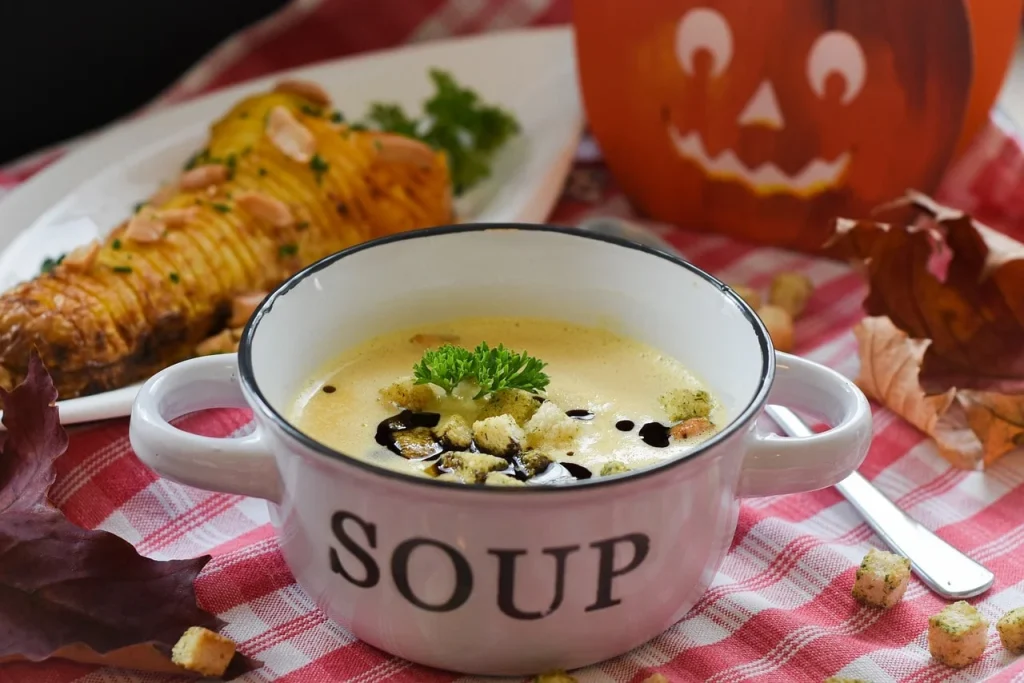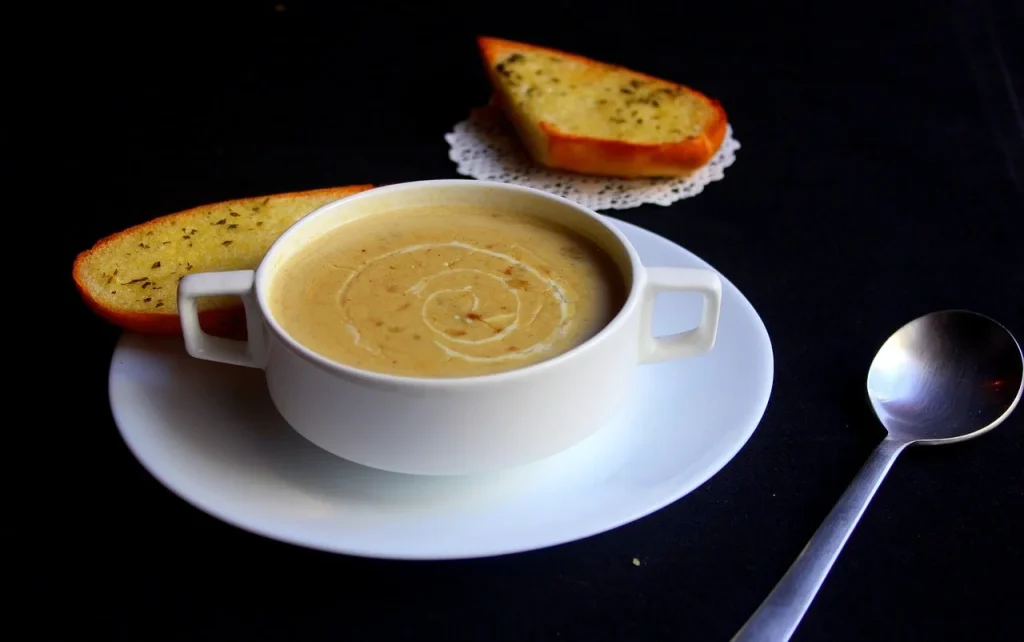Welcome to the soup lover’s paradise! If you thought it was just something to slurp on a cold day, think again. From the creamy touch of a well-made bisque to the robust zest of a minestrone, soups are a playground of flavors.
And who can ignore the fact that it has been a global staple since the Stone Age? Yes, we’re talking about a dish that has seen it all. As we prepare to ladle out some surprising soup facts, let me ask you: do you know which country considers it a breakfast dish? Let’s find out.
Soup is the song of the hearth… and the home.
Louis P. De Gouy
Soup Facts
Let’s start our journey into the savory world of soups! As you read the flavorful facts ahead, remember that a quiz awaits at the end. Test your knowledge and prove your expertise on this delicious topic.
- The earliest archaeological evidence for broth-like meals dates back to 20,000 BC, found in Xianrendong Cave, China.
- In 600 AD, the first known recipe book, Apetius’ “De Re Coquinaria,” contained instructions for what we would recognize today.
- French onion soup was originally considered food for poor people, as onions were abundant and easy to grow.
- Tomato soup became popular in the US only after the invention of canning in the late 1800s.
- The largest-ever portion was created in South Africa in 2018, weighing over 6,600 kg.
- Gazpacho, a cold variety, originated from the Roman soldiers who carried vinegar to mix with vegetables.
- “Pho” from Vietnam is traditionally eaten for breakfast.
- In Switzerland, a popular custom involves serving it to newlyweds from a communal pot, symbolizing unity.
- Chicken noodle was hailed as a remedy for the common cold after a 12th-century physician prescribed it for respiratory illness.
- Japan’s Miso is a direct descendant of a Chinese paste, evolving significantly after entering Japan around 7th century AD.
- Consumption increases during winter months by approximately 60% worldwide.
- The word “restaurant” originally referred to a French broth promoted as an “excellent restorative” for health.
- Scottish mutton types were once believed to possess qualities that could raise the dead, leading to the nickname “Scotch broth.”

- Chowder comes from the French word chaudière, a type of pot used by fishermen to cook stews at sea.
- In 2016, astronauts aboard the International Space Station grew and ate lettuce, paving the way for fresh ingredients in their meals.
- Russian “Borscht” is so important that an old saying states: “Without it, there is no lunch.”
- Potatoes weren’t added to Irish varieties until the Americas were discovered and the crop was brought to Europe.
- The first instant type was created by Knorr in 1873, consisting of dried vegetables, fat, and salt.
- It’s common in Colombia to add a small shot of heavy cream to add richness and balance.
- Bone broth has recently gained popularity for its supposed health benefits, including improving joint health and reducing inflammation.
- It was customary for French chefs to serve creamy varieties in cups with handles in the 1800s, a precursor to modern soup bowls.
- An ancient Greek tradition holds that it is bad luck to stir a pot counter-clockwise, believed to invite evil spirits.
- Buddhist monks are traditionally forbidden from eating after noon and often make a meal their last one of the day.
- During the Middle Ages, thick types were served on sops of stale bread, which is where the term “supper” comes from.
- Garlic types, popular in Spain, were historically prescribed to ward off diseases and plagues.
- “Soup kitchens” first emerged during the Great Depression, serving as crucial feeding points for the unemployed and homeless.
- In Turkey, tripe is commonly consumed as a remedy after a night of heavy drinking.
- Legend has it that the idea for the canned condensed variety came to a company executive in 1897 after seeing condensed milk.

- In some cultures, it is believed that sharing a pot strengthens community and familial bonds.
- Mongolian herders would traditionally make a milky variety using whatever meat was on hand, often horse or yak.
- Black garlic, an ingredient in some modern recipes, was developed in Korea and is prized for its antioxidant properties.
- The world’s most expensive, the Buddha Jumps Over the Wall, contains shark’s fin, quail eggs, and other luxury ingredients.
- During the 1950s, cream of mushroom was so popular in America that it was called the “housewife’s best friend” for its versatility.
- In the 18th century, turtle was considered a delicacy in England, often served at state banquets.
- The “Magic Soup Diet,” based on cabbage, became popular as a weight loss strategy in the 1980s, though its effectiveness is disputed.
- In the Amazon, some communities add exotic ingredients like turtle or piranha.
- Seaweed, used in many East Asian varieties, is known for its high content of vitamins and minerals.
- A flask was an essential item for knights in the Middle Ages, as it was used to carry broth that helped sustain them during battles and travels.

- Many chefs judge a cook’s skill by their ability to make a clear and flavorful consommé.
- The “soupçon”, a French term for a tiny amount of something, literally means “a suspicion,” originally used to describe seasoning to taste.
- In 17th century France, it was fashionable to consume a highly expensive and elaborately prepared potage called “potage à la Reyne.”
- America consumes approximately 10 billion bowls of tomato soup annually.
- Clam chowder was introduced to the northeastern United States by French, Nova Scotian, or British settlers.
- Italian wedding was named for the marriage of flavors in the broth, not for actual weddings.
- The earliest versions in ancient civilizations were simple and primarily vegetable-based, reflecting the diets of the common people.
- Storing in copper pots was common in ancient times due to copper’s natural antibacterial properties.
- A study showed that sniffing its aromatic steam can help relieve congestion symptoms due to colds and sinus infections.
- Chefs in the Middle Ages would often serve elaborately decorated dishes, which were a display of their skill and creativity.
- The Guinness World Record for the largest pot of it includes 25 chefs and over 1,000 participants to serve.
- During the Renaissance, it was fashionable in Italy to serve highly sophisticated versions at banquets, where they would often feature exotic spices brought back from the East to demonstrate wealth and status.
Soup Myths

Now that we’ve explored the facts about soups, let’s dive into separating truth from myth. There’s a lot of folklore out there, and it’s time to see what really holds up.
- Soups Are Not Filling
They can be quite satiating when they are prepared with a good mix of proteins, fats, and fibers. It is commonly observed that ingredients like beans, meats, and hearty vegetables add substantiality to soups. - Cream Soups Are Unhealthy
While cream soups are often perceived as unhealthy, their nutritional value depends largely on the ingredients used. Low-fat milk or plant-based creams can be used, which makes these soups healthier options. - Soup Nutrition Is Lost During Cooking
It’s a common misconception that cooking soup leads to significant nutrient loss. However, most nutrients are retained in the broth, ensuring that the nutritional benefits are preserved. - Only Fresh Ingredients Make Good Soup
Good soup can also be made using frozen or even canned ingredients. The convenience and accessibility of these ingredients are embraced without compromising much on taste or nutritional value. - Soups Are Just for Cold Weather
Although they are popular in colder months, they are enjoyed year-round in many cultures. Chilled soups like gazpacho or cucumber-dill are perfect examples of refreshing options suitable for warmer weather.
No products found.
Soup Quotes

Let’s find out what famous figures have said about this beloved dish. Prepare to be inspired by their words, each a simmering pot of wit and wisdom. Feel free to share your quotes in the comments so I can add them to the list as well.
Soup is cuisine’s kindest course.
Virginia Woolf
Virginia Woolf highlights the gentle and soothing nature of soup, suggesting it as a nurturing and welcoming dish in the culinary world.
To feel safe and warm on a cold wet night, all you really need is soup.
Laurie Colwin
Laurie Colwin emphasizes the comforting power of soup, portraying it as a simple remedy for cold and dreary weather.
Good soup is one of the prime ingredients of good living.
Louis P. De Gouy
Louis P. De Gouy, once again, praises soup, indicating that it is essential for a high quality of life and enjoyment.
Soup is a lot like a family. Each ingredient enhances the others; each batch has its own characteristics; and it needs time to simmer to reach full flavor.
Marge Kennedy
Marge Kennedy draws a beautiful analogy between soup and family, noting how the diverse ingredients improve each other, much like the dynamics within a family.
Of soup and love, the first is best.
Spanish Proverb
This Spanish proverb playfully suggests that while love is important, the comfort and satisfaction derived from a good soup is unmatched.
Soup FAQ

As we go down to the final section before our quiz, the upcoming FAQs will serve as your last spoonful of insights. Read carefully to stew over the details we’ve shared!
- Can soups with cream be frozen?
Generally, it’s best to avoid freezing soups that contain cream, as they can separate and become grainy when thawed. If you need to freeze a creamy soup, consider adding the cream after reheating. - Are soups good for weight loss?
They can be excellent for weight loss as they tend to be low in calories but high in nutrients and fiber, which can help you feel full. Just be mindful of the ingredients and avoid high-calorie cream-based soups. - Are soup dumplings healthy?
Soup dumplings can be enjoyed as part of a balanced diet, but keep in mind that they are often high in sodium and the dough is made from refined flour. Enjoy them in moderation. - What is the best way to thicken a soup?
To thicken soup, you can use a variety of methods, such as blending some of the vegetables, adding a roux (cooked flour and fat), or stirring in a slurry of cornstarch and water. - Can I make soup in a slow cooker?
Absolutely! Slow cookers are ideal for soup-making. Just add your ingredients, set it on low for 6-8 hours or high for 3-4 hours, and enjoy a rich, flavorful soup.
No products found.
Soup Trivia

Welcome to our steamy soup quiz! Dip your spoon into these questions and see if you can soup-ercharge your knowledge. But be warned, get none right, and you might just find yourself in hot water!
Soup Merch
If you are a true fan of soups, then you definitely need to check out our merchandise. You can find T-shirts, hoodies, mugs, and tote bags for your favorite designs. Feel free to check out all the other designs in our shop.
Conclusion
As we’ve seen, soups are not just food; they are an experience. Every spoonful can take you on a journey, from your grandmother’s kitchen to exotic lands with spices you can hardly pronounce.
So, dive into the world of soups and let your taste buds lead the way. Who knows what amazing new flavors you’ll discover? Till next time, stay curious and explore more. Cheers.
1 Source Used For This Article

